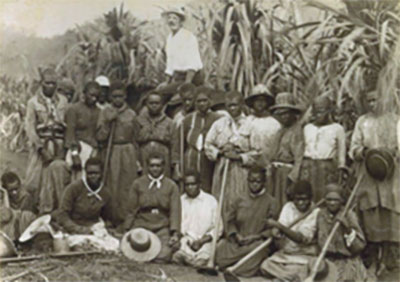Life on the West Island - Blackbirding and slavery

11 August 2022
Last year, Life on the West Island highlighted how many of our nation’s esteemed white pioneers owed their wealth and position to exploitation of slaves. Now we are hearing growing calls for truth-telling about our early colonial history in light of the pending referendum on recognising an Indigenous voice to parliament. That proposal had its origins in the Uluru Statement from the Heart, which also calls for a treaty with Indigenous Australians and a Makarrata (that is “truth-telling”) Commission similar to those held in New Zealand and South Africa to establish the facts about colonisation and dispossession of First Nations peoples.
One matter bound to come before any such commission would be the forced importation of kidnapped slave labourers from the Pacific Islands, known euphemistically by the misleading name of “blackbirding.” In July 2021, Jack Dempsey, the mayor of Bundaberg, delivered an official apology for Northern Queensland’s past reliance on the indentured labour of Pacific Islanders, many of whom were kidnapped (or “blackbirded”) and forced to work on the state’s cane plantations. “To say sorry,” explained Dempsey, “is a start in the healing and the hope for a better relationship going forward.”
It is reported that the emotional response – equal parts sorrow and relief – from the local Islander community confirmed the gesture’s importance. Writing in The Conversation, academic Jeff Sparrow noted that if the Bundaberg apology began a healing, it by no means completed it. On the contrary, the statement highlighted the inadequacy of Australia’s reckoning with its past. That’s because the practice Dempsey described – sometimes known as “sugar slavery” – was not a minor or incidental phenomenon. In fact, it was so important to plantation owners that, to defend it, they briefly contemplated separation from the rest of the colony, with Townsville mooted as the capital of what many observers dubbed a “slave state”.
Last year, then Prime Minister Scott Morrison falsely declared that there was no slavery in Australia. That was factually wrong. For instance, the man celebrated as “the father of the nation’s sugar industry” Thomas Scott, made his fortune by exploiting slaves in Antigua. He gave his name to the town of Tascott in New South Wales, but it was a former slave and lots of “blackbirded” slaves who in fact established the sugar industry there in 1823.
Over four decades, the Australian colonies – especially Queensland and New South Wales – “blackbirded” 62,000 slaves from the Pacific into work on the sugar fields and cattle stations and described them as “indentured labourers.” Many were illiterate and were persuaded to “sign” exploitative contracts of servitude with their thumb prints. White settlers whose names were given to local towns – such as Benjamin Boyd (Boydtown) and Robert Towns (Townsville) – made fortunes from the labours of these slaves.
Most of the blackbirded slaves were seized under of force of arms with promises of great wealth in the colonies. Noted West Island author and civil rights activist Faith Bandler was the daughter of one such sugar slave. As a child, she had listened to her father, Peter Mussing, describing his youth. He told her about when he was kidnapped and taken into the boat by the slavers, and what it was like in the boat coming over from his island Ambrym in the New Hebrides, and how rough it was and how they were all held in the hull and how sick they were and those who died would be thrown overboard and how it was when the boat would arrive in Australia and how strange everything seemed to him.
Jeff Sparrow points out that the West Island practice was at odds with that of the “mother country:” Paradoxically, such experiences – so reminiscent of the Middle Passage endured by slaves brought across the Atlantic Ocean – coincided with a hardening of official hostility to slavery throughout the British Empire. In 1833, the parliament in Westminster had officially legislated abolition, with enslavement thereafter disdained as contrary to English principles of liberty. The politicians allocated an extraordinary sum of £20 million (about 40 per cent of Britain’s total income) to restitution: an amount granted not to the slaves but to their owners, compensation to them for the loss of their “property”.
On the West Island, “indentured” South Sea islanders were not technically defined in law as slaves and most received some payment for their labours. But Sparrow is clear that these workers were effectively enslaved: the reason the sugar barons wanted Islanders did not vary: they understood that white men could impose upon indentured non-white labourers a discipline that Europeans would not accept. They could pay them less (and sometimes not at all). They could beat them and belittle them and abuse them, confident no law would intervene, and they could work them relentlessly under regimes that regularly proved fatal. The Australian press described the Islanders as “kanakas”. In its original, Hawaiian context, kanaka meant “free man”. In Australia, it signalled the opposite, as no less an authority than the Queensland Governor confirmed.
By 1884, the annual mortality rate for Islanders in Queensland had climbed to 147 deaths per 1000 people. The reason was plain: as the Brisbane Courier reported, the causes of mortality were indisputably plain; the Islanders were being killed mainly by overwork, insufficient or improper food, bad water, absence of medical attention when sick, and general neglect
Thousands of documents and contemporary media reports confirm that “blackbirding” was analogous to slavery. This shows that the time has come for truth-telling about the West Island’s history of savage treatment of First Nations and Islander peoples. A Makarrata Commission might be a good first step.